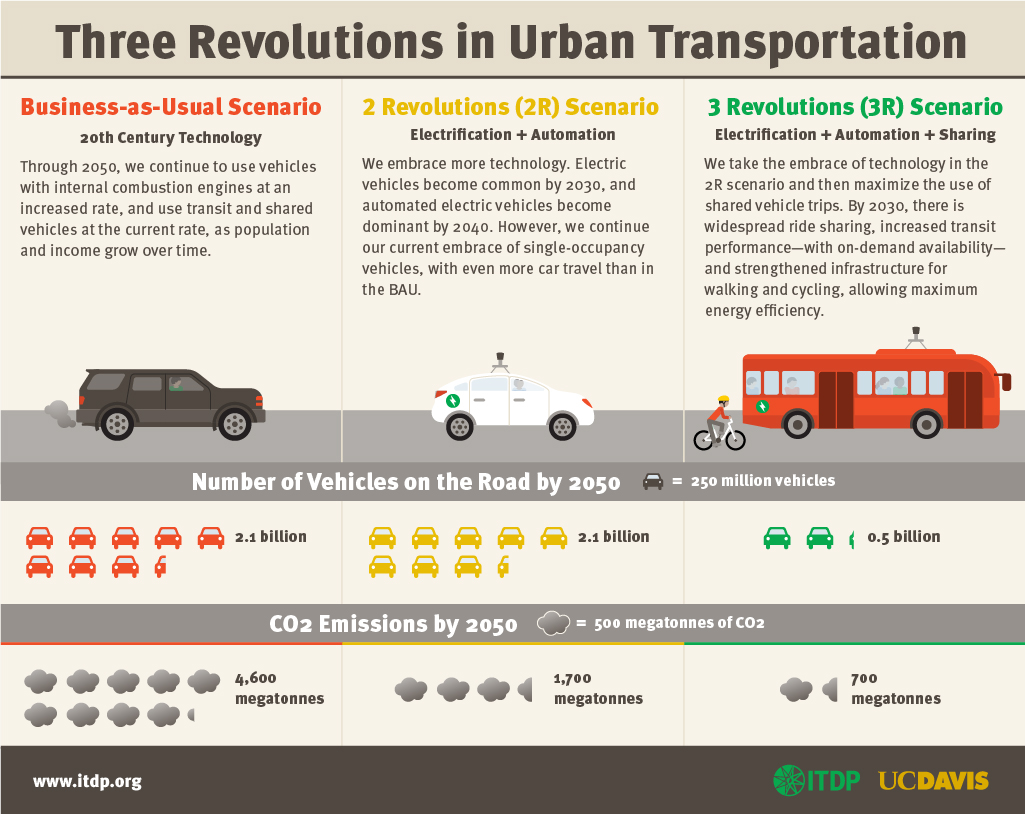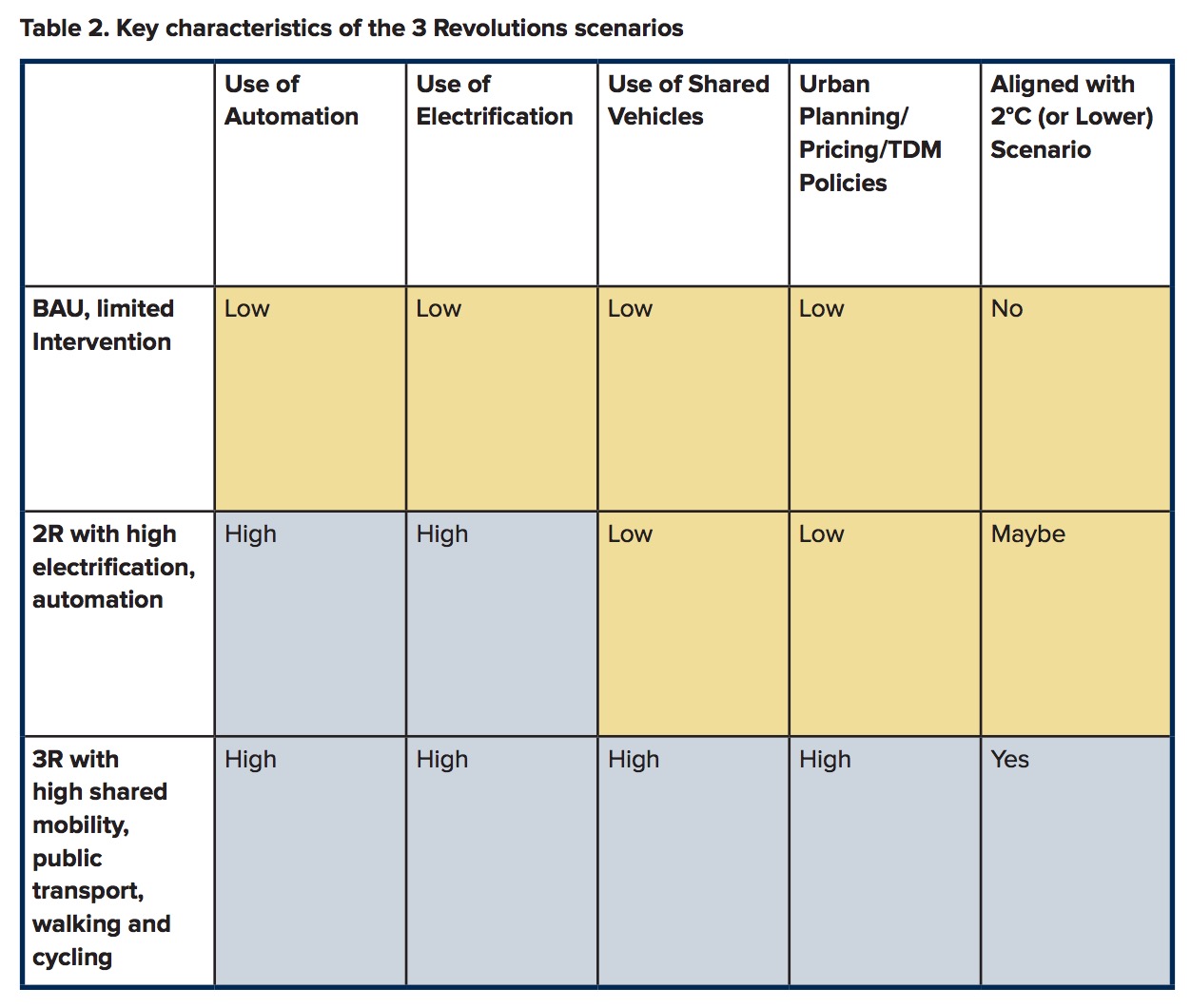INSTITUTE FOR TRANSPORTATION & DEVELOPMENT POLICY (ITDP)
UC DAVIS SUSTAINABLE TRANSPORTATION ENERGY PATHWAYS
Executive Summary
The world is on the cusp of three revolutions in transportation: vehicle electrification, automation, and widespread shared mobility (sharing of vehicle trips). Separately or together, these revolutions will fundamentally change urban transportation around the world over the next three decades.
Each revolution addresses different societal needs, but can also lead to societal costs:
- Vehicle electrification can cut vehicle energy use and CO2 emissions. However, for electrification to have maximum benefits, power generation must be strongly shifted away from fossil fuels and deeply decarbonized. In addition, these vehicles will likely remain expensive for at least one more decade.
- Automation can provide important safety benefits, reduce labor costs, and enable cheaper travel and more productive use of time. However, by lowering the cost of travel in terms of time and money, automation would likely induce more travel and dramatically reduce the number of jobs in transportation.
- Shared mobility, whether through shared vehicle trips or public transport, can lead to more efficient use of urban space, reduce traffic congestion, enable more walking and cycling, cut energy use and emissions, and generally improve urban livability. However, this would require large increases in load factors (passengers per vehicle trip), and a range of strong policies to achieve.
Together, the positive and negative aspects of each revolution will interact in many complex and difficult-to-predict ways. This report may be the first to attempt to quantify how these major changes could evolve and interact on a global and regional basis out to 2050. It considers possible end states, as well as transitional pathways and policies needed to get there.
Our central finding is that while vehicle electrification and automation may produce potentially important benefits, without a corresponding shift toward shared mobility and greater use of transit and active transport, these two revolutions could significantly increase congestion and urban sprawl, while also increasing the likelihood of missing climate change targets. In contrast, by encouraging a large increase in trip sharing, transit use, and active transport through policies that support compact, mixed use development, cities worldwide could save an estimated $5 trillion annually by 2050 while improving livability and increasing the likelihood of meeting climate change targets.
Methodology
We build on two recent reports published by ITDP and UC Davis’s STEPS program: “A Global High Shift Cycling Scenario” (2015) and “A Global High Shift Scenario: Impacts and Potential for More Public Transport, Walking and Cycling with Lower Car Use” (2014). Both reports took a scenario approach to consider the role of different travel modes in providing mobility, and the amount of potential energy savings and CO2 reduction that could come from a less car-centric world in the future (Mason, Fulton, & McDonald, 2015; Replogle & Fulton, 2014).
This report expands upon the scope of the previous studies by considering the role of electrification, automation, and ride sharing (more people per vehicle) in developing future scenarios. The possible types of impacts are well documented, and researchers have begun to estimate how various combinations of impacts – such as people spending more time in their cars, or on-demand mobility trips substituting for public transport – may affect travel and energy use. But most studies have not explicitly projected numeric scenarios into the future or attempted to characterize how various interactions could play out. As with our previous modal shift studies, this study is global, breaking the world into eight regions including five major markets: United States, Europe, China, India, and Brazil.
We have developed our present analysis using three main urban travel scenarios: a business-as-usual scenario, a technology-dominated 2 Revolutions scenario, and a technology + high shared-mobility 3 Revolutions scenario. These are elaborated from a base year of 2015 through 2050 as follows:
- Business-as-usual (BAU) scenario – This scenario assumes few changes from 2017 travel patterns and current trends through to 2050. No major revolutions occur. It assumes internal combustion engine (ICE) light-duty vehicles (LDVs) remain dominant or grow in dominance, depending on the country, through 2050, and applies population and growth projections with these assumptions in mind.
- 2 Revolutions (2R) scenario – This is a technology-focused scenario that includes rapid vehicle electrification along with – but starting later – rapid automation. Electric vehicles (EVs) achieve a significant share of vehicle sales by 2025 in leading countries, with automated EVs reaching this stage about five years later. Both are dominant around the world by 2050. This scenario contains no significant increase of shared vehicle trips through new technology; it preserves the BAU trends toward a private-car-dominated world.
- 3 Revolutions (3R) scenario – This scenario includes widespread vehicle electrification and automation, and adds a major shift in mobility patterns by maximizing the use of shared vehicle trips. This scenario includes all three revolutions, and is a strongly multi-modal scenario, with increased availability of vehicles for shared trips, increased public transport availability and performance (including on-demand small bus services, larger buses and rail), and significant improvements in walking and cycling infrastructure and therefore in travel by these modes.
Other scenarios with different combinations of these revolutions could be considered; the choices made here are intended to simplify these complex scenarios and highlight certain features. And although we cannot accurately predict the interactions that each step of each revolution will have on the others, our scenarios create paradigms of travel that we can use to quantify the energy and CO2 impacts and begin to develop policies to guide the world toward the most societally optimal outcomes.
Download full version (registration required): Three Revolutions in Urban Transportation
About the Institute for Transportation & Development Policy (ITDP)
www.itdp.org
ITDP is a global nonprofit at the forefront of innovation, providing technical expertise to accelerate the growth of sustainable transport and urban development around the world. Through our transport projects, policy advocacy, and research publications, we work to reduce carbon emissions, enhance social inclusion, and improve the quality of life for people in cities.
About Sustainable Transportation Energy Pathways (UC Davis STEPS)
https://steps.ucdavis.edu/
STEPS is a multidisciplinary research consortium, part of the Institute of Transportation Studies at UC Davis.
Tags: Automation, Electric Vehicles, EVs, Institue for Transportation & Development Policy, ITDP, Sustainable Transportation Energy Pathways, UC Davis








 RSS Feed
RSS Feed
A very subjective and biased analysis made by people with academic pedigrees but without actual competence. It is unfortunate for us all that so much drivel dominates discussion in circles of influence.
Urban transportation revolution due to electricity and automation, has been cited at least since Fall 2016. But system synthesie as presented here ignores traveler demands that do not match the smart growth template. After about 30 years, and many $billions, there is failure to to demonstrate the smart growth core; meaningful auto to mass transit transfer. It illustrates the demand for on-call personal same vehicle travel direct to actual destinations. On-call service, (aka “Uber”), by competing companies operating in several cities, with needed door to door capability. Thus overcoming mass transit “first/last mile” access deficiency. And can meet the public demand, as do nearly 90% of travel, now with auto access, for flexible service to all travelers, especially non-drivers, now dependent on mass transit.
Thus an equality for all pragmatic long term Plan:
-Uber, and competitors become 24/7 Regional Public Transportation. The transfer can start immediately with human drivers, with increasingly very efficient autos to meet energy and emissions standards.
-Mass Transit provides capacity augmentation on some very active corridors during peak periods, and for high attendance events. It is relieved of its off peak wasteful heavy vehicle service.
-Ancillary service, walk, bike, etc, are encouraged to the degree they are travel cost-effective. Vehicle sharing encouraged.
-“Sprawl”, density, etc., are public opinion decisions. Not determined separately by transportation, or negative or positive rules for their operation.
-It appears total costs, including capital, are similar for new mass transit, and Uber,etc. Operating subsidy for declining mass transit becomes available for new start-ups if needed, including fare adjustments.
-Despite sharing, Uber,etc., Region VMT may increase, and in some dense growth areas road and or guideways increase. Vehicles built to demanding Region efficiency specifications will be used by all. High value land les used for parking will be available as Uber,etc., increase.
This Plan’s primary advantages:
1), Role change for Auto/highway and for mass transit allow them to help each other provide superior service, rather than compete.
2), Challenge to meet stiff GHG and environment standards, and decide role of self-driving autos is high quality design engineering. Ned for unusual community design, and negative means to punish auto ownership and use are eliminated.
3). Pragmatic changes provide data and experience as a basis for introduction of new designs.